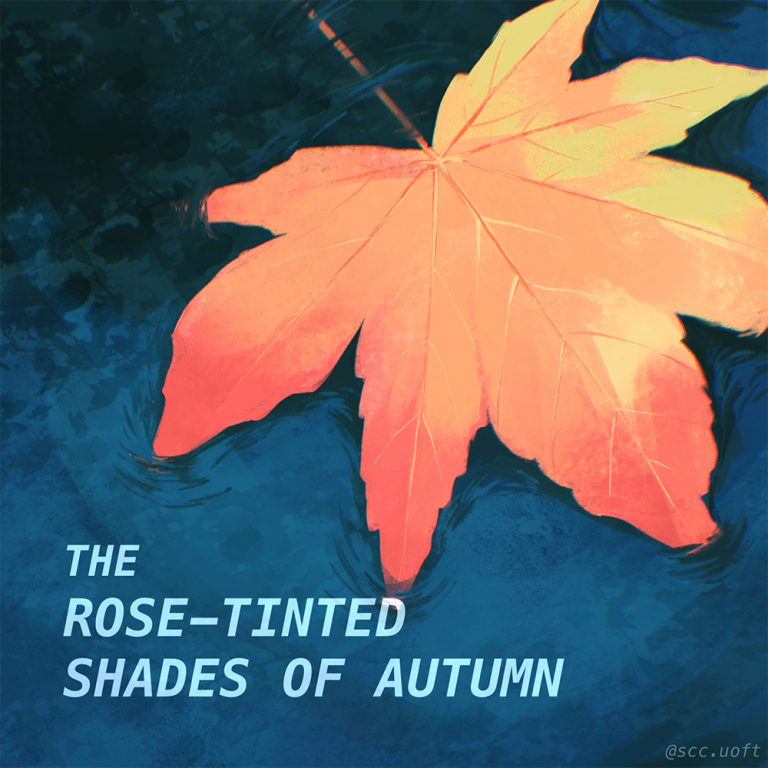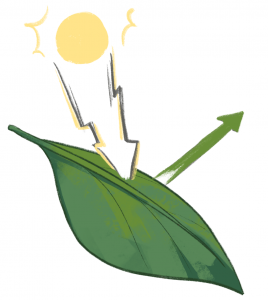
Written by Shanzeh Ahmed
Illustrated by Shanling Lei
Who doesn’t love to walk around on a crisp autumn afternoon, listening to the satisfying crunch of the fallen leaves under our boots, and enjoying the speckled array of the reds, yellows and oranges around us? It happens every year, but have you ever wondered why some leaves fall and others don’t? Or why there’s such a variety of colours?
The mystery of why some trees, like maples, shed their leaves, while others, like pines, may not, comes down to energy. Anyone who has ever tried to take care of a houseplant knows that keeping them happy takes effort. They have their own set of needs, which need to be met for them to be healthy. Most plants are autotrophic, meaning that they can make their own food for energy using a process called photosynthesis, but this requires access to water and sunlight, and involves a green pigment called chlorophyll. As winter approaches, the days get dryer and darker. There are simply not enough resources for certain plants to maintain a full head of leaves. These are the deciduous plants that are the staple of autumn. They will annually shed their leaves to prevent diverting resources for their upkeep. The leaves on an evergreen tree, however, are adapted for the winter season! They have a waxy coating around them, which makes it easier for snow to slip right off them and reduces the amount of water that can be evaporated off the surface. In that way, these leaves can be maintained with fewer resources, and thus, do not need to be shed.

What makes a leaf appear green or red or yellow? That has to do with what part of the visible spectrum of light gets absorbed or reflected back into our eyes. This is part of the electromagnetic spectrum of light that we can see and includes colours! Leaves usually appear green because of ‘chlorophyll’, the pigment previously mentioned as involved in photosynthesis, making it vital for plants. Chlorophyll absorbs the blue and red wavelengths of visible light and reflects green light, which makes leaves appear green to us! However, as plants start preparing to shed their leaves, they stop making chlorophyll; in fact, because chlorophyll is so packed with energy, trees will break it down to re-absorb that energy, before shedding their leaves completely. That allows other pigments like carotenes and xanthophylls to begin to surface, bringing forth the staple oranges and yellows of autumn. These pigments are already present in the leaves, they simply become more dominant as the chlorophyll recedes from centre stage.
However, my personal favourite, the reds, come from pigments called anthocyanins. These are not usually present in the leaves but are actively made! Why do trees choose to do this when they are about to shed their leaves anyway? We don’t have a clear answer on this yet. Most theories consider it to be the trees’ attempts to ward off insects like aphids, which seem to be more attracted to yellow than red. Interestingly, trees in Europe don’t tend to do this whereas in North America, red leaves are more common!
Although it signals cold days ahead, the beauty of autumn comes from its signature splash of colours¬—a beauty that emerges when these pigments inside leaves finally get their time to shine!
Sources:
- Dr. Biology. “Why do leaves change color in the fall season?”. ASU – Ask A Biologist. 16 May 2017. ASU – Ask A Biologist, Web. 18 Nov 2020. https://askabiologist.asu.edu/questions/why-do-leaves-change-color
- University of Haifa. “Why More Autumn Leaves Are Red In America And Yellow In Europe: New Theory.” ScienceDaily. ScienceDaily, 17 August 2009. .
- Feild, T.S., D.W. Lee and N.M. Holbrook. 2001. Why leaves turn red in autumn. The role of anthocyanins in senescing leaves of red-osier dogwood. Plant Physiology 127:566-574.